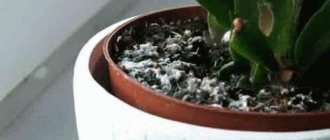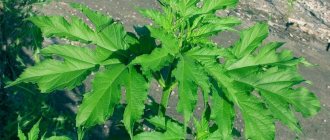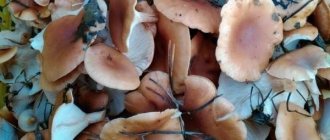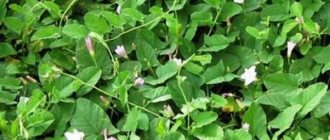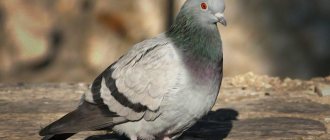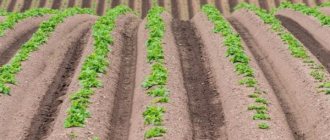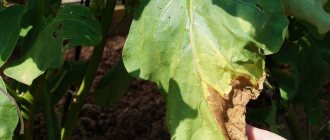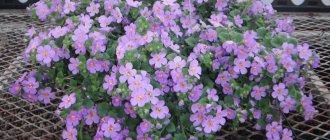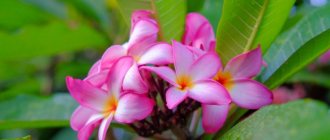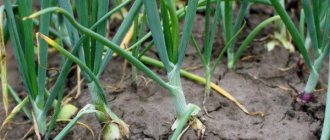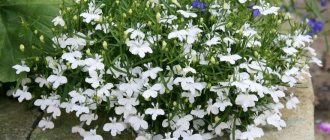Natalya Popova Found out the characteristics of the variety
Ambrosia wormwood is an annual herbaceous weed of the Asteraceae family. Homeland - North America. It came to Russia in the last century, through seeds brought by traders from the American continent. At first, ambrosia grew in the fields of the Krasnodar Territory, in similar climatic conditions to its natural habitat on its native continent. Then, having demonstrated a high ability to adapt, the weed began to rapidly conquer new lands - the Caucasus, the Black Sea region, the Volga region, the Far East, right up to the Pacific Ocean.
Currently, on the territory of the Russian Federation, the plant has been assigned the status of a dangerous quarantine weed that can cause harm to farmland or other plants.
This means that any plant material (wheat, corn, rye, etc.) in which seeds or parts of the ragweed plant are found is prohibited from being exported from the region. The procedure is aimed at containing the spread of the aggressor.
Description and preparation
Ambrosia wormwood has a long powerful tap root, an erect branched pubescent stem up to 30 cm tall (reaching up to 2.5 meters in height in certain conditions) and large pinnately divided leaves - gray-green, pubescent on the underside, and green and smooth on top . The lower leaves are petiolate, and the upper ones are sessile. It is for the leaves, reminiscent of the leaves of wormwood, that the plant got its name. From July to October, ragweed blooms with small yellow flowers collected in a spike-shaped inflorescence. In August, the fruits begin to ripen - achenes in a wrapper. In folk medicine, the herb and inflorescences of ragwort are used. Grass harvesting is carried out starting in August and throughout the fall.
Types of ragweed
There are about 50 species of ragweed in the world. In Russia and the CIS countries, in addition to ragwort, 2 more species grow:
Weed ragwort
| |
Ambrosia tripartite weed
|
Chemical composition and properties
Ambrosia wormwood is rich in: cumanin, quercetin, essential oils, hydroxycinnamic acids, sesquiterpene compounds and other substances.
Pollen contains an allergen - ambrosic acid and inhibitors of cancer cell growth. The seeds are rich in vegetable oil.
In folk medicine, ragwort is recommended for:
- fever;
- hypertension;
- gastritis, enterocolitis;
- gastrointestinal disorder;
- helminthiasis;
- diseases of the nervous system;
- convulsions;
- oncological diseases;
- osteochondrosis, radiculitis, arthritis;
- bruises, sprains;
- wounds, ulcers.
In homeopathy, allergic reactions are treated with the help of this plant.
Infusion (general recipe):
- 2 tbsp. crushed dry leaf;
- 300 ml boiling water.
Pour boiling water over the ambrosia leaves and let steep for 30 minutes. Strain. Take 2 tablespoons of the prepared infusion 3-6 times a day.
This remedy is recommended for fever, stomach diseases, and also for the prevention of rectal cancer. For sprains, bruises, and joint diseases, this infusion is used externally in the form of lotions.
- 1 part of flowers or inflorescences of ragwort;
- 5 parts vodka.
The tincture is used for diseases of the stomach and intestines, convulsions, and neurasthenia. Pour vodka over the ambrosia and place it in a dark place for 7 days. Strain the resulting tincture. Take 25-30 drops 3 times a day 30 minutes before meals. The recommended course of treatment is 30 days. Ambrosia oil for external use:
- 1 part fresh leaves and flowers of ragweed;
- 5 parts olive oil (can be replaced with mustard or rapeseed oil).
Pour oil over the ambrosia and let it brew for 14 days. Use the finished oil to treat wounds and ulcers. For radiculitis, osteochondrosis, edema, tumors, the juice of ragwort and its leaves are used to prepare compresses for sore spots.
Using the healing properties of ambrosia
Although ragweed is criticized for its allergic pollen, it can also bring benefits to humans. The plant contains essential oils, vitamins and mineral salts. In folk medicine, all parts of the plant are used, including the seeds. Use as:
- febrifuge;
- remedy for bruises and hematomas;
- remedy for radiculitis;
- a herb that normalizes the functioning of the gastrointestinal tract.
Only a doctor can prescribe ragweed as a preventive measure!
If you have any questions, you can ask them in the comments below.
X
Contraindications
Ambrosia wormwood is contraindicated:
- children;
- pregnant and nursing mothers;
- for asthma;
- for allergic reactions.
Ambrosia should be used for treatment only after consultation with your doctor, since the use of various products prepared on the basis of this plant can lead to allergic reactions. An allergy to ragweed is manifested by: itching, runny nose, vomiting, loose stools, sometimes swelling of the throat, an asthmatic reaction and can even lead to anaphylactic shock.
Related article: Codonopsis lanceolata - beneficial properties, description
When ragweed blooms - what to do if you have allergies?
The pollen of this plant is one of the strongest allergens in the plant kingdom. For hay fever to appear, it is enough to inhale 4-5 pollen grains. Symptoms of an allergy to ragweed are typical: sneezing, soreness of the pharynx and larynx, swelling of the eyelids and profuse lacrimation - however, they develop very quickly and with triple force.
An allergic reaction such as asthma is very likely, which is accompanied by suffocation and a panic attack. Significant discomfort during the flowering period of the weed is a reason to immediately consult a doctor, who will select antihistamines or hormonal drugs, eye drops and specific immunotherapy suitable for a particular person.
Ambrosia pollen is one of the strongest allergens
Ambrosia wormwood, allergy to ragweed - description, beneficial properties, application
Ragweed is an annual or perennial herb of the Asteraceae family, and is one of the dangerous quarantine weeds. It is distinguished by an erect and grooved stem, a taproot, powerful and long root, the height reaches two meters. It has large leaves that reach 15 cm; they can be pinnately dissected. They are light green above and slightly gray below. Ambrosia flowers are five-toothed, can be collected in an inflorescence in the form of a spike, and consist of sixteen different flowers - yellow-green or yellow. It begins to bloom in mid-summer and ends in mid-autumn, it all depends on what type of ragweed.
Why is ragweed dangerous?
Ambrosia is a dangerous quarantine weed that easily takes root in a new place and is aggressive towards other plants. Contaminates field crops, especially vegetables and row crops.
The impact of ragweed on cultivated plants is extremely negative:
- Dense foliage creates dense shade, shielding cultivated plants from light.
- Displaces cereals and legumes and reduces their feeding qualities.
- Its powerful root system draws all moisture and nutrients from the soil, dries and depletes it.
Warning! Dense thickets of weeds can make a site completely unsuitable for growing agricultural plants in 2 years. The proximity of the latter to ambrosia entails their withering and death.
When harvesting, the stems of ragweed clog the cutting mechanisms of agricultural machinery, which reduces the productivity and quality of raw materials, which require additional cleaning.
Attention! The weed can influence the production of meat and dairy products. Its presence depletes the soil, resulting in a decrease in the amount of nutrients in the feed.
Cattle eat feed poorly and reluctantly if it contains the weed ragweed, and subsequently produces meat and milk with a characteristic bitter taste and pungent odor.
Ambrosia is also dangerous for people: the plant produces a large amount of pollen, which has the highest allergenicity index. When people come into contact with it, various diseases of allergic etiology occur:
- rhinitis, manifested by nasal congestion, sneezing, swelling and itching of the nasopharynx, difficulty breathing;
- conjunctivitis, which causes lacrimation, itching, redness and swelling of the mucous membranes, their irritation and inflammation;
- bronchitis and its possible complication – bronchial asthma;
- with direct contact with pollen, dermatitis may occur, accompanied by rashes and itching;
- intoxication – manifested by headache, increased fatigue, weakness, and sometimes sleep disturbances;
- anaphylactic shock.
Ragweed pollen is a very aggressive allergen. After a long period of inhaling air saturated with it, even an absolutely healthy person can become allergic.
Description of ragweed
There are up to 40 different types of ragweed. Most often it is found in the Northern part of America, from there it was brought to us. In Russia, the following types of ragweed are popular: tripartite, holomepaniculate, wormwood; it is most often used in traditional medicine for homeopathic purposes.
This weed can live in the southeastern, southern regions, Primorye, Volga region, and Ukraine. They can litter vegetable gardens, orchards, pastures, forests and banks.
They have a developed powerful root, thus drying the soil and preventing other plants from developing.
Useful properties of ragwort
This type of plant is controversial, which is why it is so important not to experiment, not to self-medicate, and to consult a specialist.
Ambrosia pollen causes a powerful allergic reaction, it all depends on how the human body is built.
Ambrosia is rich in vitamins, microelements and other useful substances, with which you can overcome many diseases. The herb is widely used for hypertension, fever, dysentery, diarrhea, severe wounds, bruises, if a person has helminths or other parasites.
Research confirms that ragweed has bactericidal properties, and with the help of the plant you can protect yourself from cancer.
Applications of ragwort
The aerial parts, roots, seeds, pollen and flowers are used in medicine. The aerial part contains cinerol and camphor; the seeds are rich in essential oils.
The plant is used to prepare infusions with alcohol or water, as well as oil extracts, they can be taken internally and externally. Ambrosia juice will help get rid of some diseases.
To prepare an infusion of ragwort, you will need 400 ml of boiled water, two tablespoons of dry plant, leave for up to 30 minutes.
Drink two tablespoons up to six times a day. It is recommended to drink the infusion if a person is worried about fever, gastritis, enterocolitis; it is also a reliable remedy for the prevention of cancer that develops in the rectum. It is recommended to use it externally if you are bothered by pain due to rheumatism, arthritis and muscle strain.
To prepare a tincture of ragweed, you need to take fresh flowers, chop them finely, add alcohol or vodka, and leave for at least one week. Drink 30 drops 30 minutes before meals for one month. It is good to use it if a person is prone to convulsive conditions, with diseases of the stomach and intestines, and various neurasthenia.
The oil extract is used externally to heal ulcers, wounds that take a long time to heal, and other lesions of the skin and mucous membrane. To prepare it, you need to finely chop the leaves and flowers, then pour mustard, olive and rapeseed oil over them and leave for up to two weeks.
In cases of tumors, osteochondrosis, edema, radiculitis, compresses with ambrosia juice and fresh leaves are recommended; they should be applied to the affected areas of the skin.
Ambrosia wormwood - the queen of quarantine weeds
Testing the effectiveness of using laboratory samples of microbial preparations against ragwort
Scientists from the Federal State Budgetary Institution "Research Institute of Agriculture of the Crimea" are testing the effectiveness of using laboratory samples of microbial preparations based on promising strains against the harmful weed - ragweed.
Ambrosia artemisiifolia L) is a genus of annual or perennial herbs of the Asteraceae family. The generic name of the plant comes from the mythology of ancient Hellas, where the word “ambrosia” is interpreted as “food of the Gods.” The insidious enemy can be found in personal plots, along roads, and in the southern regions - in every vacant lot. In many green areas of southern Russia, local thickets of ambrosia have taken over large areas. The crop is included in the list of quarantine plants, as it is a strong allergen and is considered the most common weed. In addition to economic damage, the plant causes significant harm to human health. Allergists consider tiny ragweed pollen one of the most aggressive allergens, which, along with an allergic reaction, can also cause asthma. During the mass flowering of the weed, in places where it is widespread, the level of the maximum permissible concentration of pollen in the air is exceeded several thousand times, so the problem becomes widespread. No other weeds and trees have such a wide range of effects of pollen on human skin and mucous membranes. However, there is also a second side to the coin: ambrosia is used in official medicine and as a medicinal plant. Despite the fact that the culture is a strong allergen, it often acts as the basis of medications, including antihistamines.
In turn, ragweed causes significant damage to agriculture: it dries out and depletes the soil, has a detrimental effect on crop yields, in fields littered with ragweed the productivity of agricultural machinery decreases, the quality of field work deteriorates and harvesting becomes difficult. In modern conditions of agricultural production, there is a need to review existing approaches to combating this species and develop effective, environmentally friendly methods and technologies aimed at reducing its harmfulness, reducing the production of pollen and seeds, and localizing outbreaks.
Currently, ambrosia has a large distribution area both in the Republic of Crimea and in the south of Russia. At the same time, it has practically no pests and diseases, and no competitors among weeds. The seeds are very “tenacious”, reproduce well and adapt to different natural and climatic conditions.
Leading Researcher of the Laboratory of Plant-Microbial Interaction of the Department of Agricultural Microbiology of the Federal State Budgetary Institution "Research Institute of Agriculture of Crimea" Svetlana Vitalievna Didovich
According to the leading researcher of the laboratory of plant-microbial interaction of the department of agricultural microbiology of the Federal State Budgetary Institution "Research Institute of Agriculture of Crimea" Svetlana Vitalievna Didovich, the harmfulness of ragweed for agrophytocenoses is extremely high. Without solving the problems of protecting agro- and phytocenoses, it is impossible to seriously consider the tasks of increasing the efficiency and stability of agricultural production and the environmental safety of the region. Focusing on the greening of crop production, a priority in the near future will be the search for ecosystem-safe biological products that are alternative to chemical herbicides and the development of biomethods for protection against weeds. In recent years, new approaches to the biological method of weed control have been developed, namely the use of pathogenic microorganisms, phytophagous insects, and mycoherbicides. In world and domestic practice, microbial preparations based on microorganisms and their metabolites for controlling the number of weeds number no more than a dozen. Currently, within the framework of a grant from the Russian Foundation for Basic Research and a state assignment from the Russian Academy of Sciences, scientists from the Department of Agricultural Microbiology of the Federal State Budgetary Institution "Research Institute of Agriculture of the Crimea" are carrying out a block of research to search for microorganisms that are inhibitors of ragwort. It is worth noting that in 2019, for the first time, in field conditions on southern chernozem in the foothill and steppe zones of Crimea, together with scientists from the All-Russian Institute of Plant Protection, tests were carried out on the effectiveness of using the phytopathogenic strain Stagonosporopsis heliopsidis from the collection of the All-Russian Research Institute of Plant Protection as a potential bioagent of mycoherbicide, as well as cyanobacterial consortia based on cyanobacterial strains from the collection of the Federal State Budgetary Institution "Research Institute of Agriculture of Crimea" against ragwort. A few days after treatment, the first ragweed lesions were observed (chlorotic spots and plant wilting). Bacterization with mycoherbicide provided 17.7% of the incidence of damage and death of Ambrosia artemisiifolia L. plants, and with a cyanobacterial consortium - up to 20% of plant death. This may become the basis for the creation of bioherbicide preparations for this quarantine weed.
The team of scientists still has to solve many complex problems: develop recipes for preparative forms based on these microorganisms, study doses and timing of plant treatment, test new isolated strains - weed inhibitors.
– At the end of April of this year, researchers from the Federal State Budgetary Institution “Research Institute of Agriculture of Crimea” began laboratory and field experiments with ragweed wormwood - they are testing new and promising strains that have an inhibitory effect on the growth and development of weeds. This direction is very promising, in demand, and most importantly innovative. At the first stage of laboratory research, scientists are studying the effectiveness of inhibition of ragweed plants in the phases of germination and 2, 4, 6 true leaves. The plant has a high adaptive potential, in this regard, it is important to assess the reaction of the enzymatic system and the productivity potential of plants, to establish the most vulnerable phase of ragweed development during bacterization, emphasized Svetlana Vitalievna Didovich, Candidate of Agricultural Sciences.
To summarize, it is necessary to note the importance and necessity of developing biological products with phytotoxic and herbicidal effects, and to note the modernity and relevance of these studies. It should also be taken into account that the study of the mechanisms of the herbicidal effect of microorganisms on weeds in agrocenoses is of fundamental importance. In addition, the implementation of such a comprehensive project in the Republic of Crimea will make a real contribution to practical achievements in reducing the pesticide load and combating quarantine plants in accordance with the priority areas of modernization and technological development of the economy of the Russian Federation.
Marina Davidkina, producing editor of the laboratory of publishing work of the Federal State Budgetary Institution "Research Institute of Agriculture of Crimea".
PHOTO: from the archives of the Federal State Budgetary Institution "Research Institute of Agriculture of Crimea"
Contraindications for ragwort
In no case should you take preparations based on ragweed for various forms of allergic reactions, if a woman is pregnant or breastfeeding, or if you have an individual intolerance to some of the chemicals that make up the plant. Before using the drug, it is very important to ask your doctor everything in detail; if an allergic reaction develops, you need to take an antiallergic drug and immediately stop taking the drug.
Article on the topic: Wine grapes - beneficial properties, description
Allergy to ragweed
Most often, these symptoms occur during allergic reactions to ragweed:
1. Rhinitis, most often appears in people who come into contact with this type of plant, while the patient begins to sneeze, has a stuffy nose, is bothered by constant discharge from the nose, the mucous membrane of the nasopharynx swells, can be very itchy, and breathing is blocked. Complications such as allergic sinusitis, laryngitis, eustachitis may also occur, and each of them manifests itself differently.
2. Conjunctivitis, when the tissue around the eyes swells, severe itching appears, a person is afraid of light, and is bothered by lacrimation.
3. Bronchial asthma, aggravated during the period when ragweed blooms, causing attacks, may be accompanied by allergic bronchitis.
4. Atopic dermatitis, when the skin becomes inflamed, hives occur, itching appears, the skin becomes very red, and fine blistered rashes form on it.
5. One of the dangerous symptoms of an allergy to ragweed is pollen intoxication, when the patient suffers from a severe headache, is very tired, constantly irritable, very weak, body temperature rises, and sleep is disturbed.
Very rarely, atypical symptoms can be alarming - the central nervous system is affected, meningitis, arachnoiditis and encephalitis are a concern. Problems with the optic and auditory nerves may also arise, Meniere's syndrome develops, the gastrointestinal tract is affected, gastritis is a concern, and hepatitis can develop extremely rarely.
Thus, despite the fact that ragwort has beneficial properties, it is a strong allergen. If a person does not suffer from allergic reactions, you can try decoctions from this plant, because with their help you can cure diseases of the pancreas, gastrointestinal tract, improve kidney and liver functionality, and have anti-inflammatory, bactericidal and analgesic effects.
Methods to combat ragweed
Although several of its useful qualities were listed above, they, as a rule, do not play any role. And ragweed, as it was a harmful weed, remains so. And this means that it is necessary to fight it. After all, the harm associated with allergies will greatly outweigh all the good qualities of this plant, even if they were significant.
Why does ambrosia spread so well across the territory of a non-native continent? In North America, it has its own natural enemies, both insects and other plants, which limit its spread. There are no such enemies on the Eurasian continent, and the climate and soils turned out to be the most favorable. Ambrosia grows even on saline soils. Drought is not a problem for the weed due to its long root, which penetrates the soil 4 m. This does not allow the plant to be easily uprooted. Another feature of ragweed's rapid spread is the large number of seeds produced per season. Up to 150 thousand seeds can be dispersed over large areas, especially if the weather is windy. Moreover, the germination rate of the seeds is high and they can sprout even after 40 years.
With such “good” indicators, it is quite difficult to eradicate the weed. Therefore, there are many methods. The main ones are mechanical, agrotechnical and chemical methods.
The mechanical method includes mowing the weed and weeding it.
The method is effective only when the plant is at the budding stage. If you mow it earlier, during the growing season, the weed will emerge every time after mowing. Moreover, each time he will have more and more young shoots. In the end, you can skip the flowering and seeding period. Therefore, one-time mowing will not help here. It is recommended to mow up to 5 times per season. As a result, the plant will not be able to bear fruit, and after several years of periodic mowing, the roots will be exhausted and the weed will die.
For small areas where there are few weeds, the weeding method with complete removal of roots from the soil will be effective. It is necessary to select the roots very carefully, since even a small root left will take root again and give rise to a new shoot. This method is carried out more often in summer cottages. There are recommendations here that will help gardeners get rid of this harmful weed.
Agrotechnical methods include methods related to land reclamation. For example, for vacant lots, the tinning method is used. The point of the method is that ragweed is replaced by useful crops. For this purpose, winter grain plants are usually used, which greatly advance in growth and shade it. Since ragweed is a light-loving plant, such shading leads to its death. The vacated space is perfectly populated with meadow grasses, which are then used to feed livestock. Therefore, the method is usually used in hayfields and pastures.
Alfalfa, wheatgrass, fescue, foxtail, Sarepta mustard, wheatgrass, sainfoin and brome are good choices for crowding out or suppression. Often, not individual herbs are used, but a mixture of them. In just two or three years, such mixtures can completely survive ragweed. Even Sarepta mustard alone is capable of displacing this weed.
The method of crop rotation is also used. If the field turns out to be very heavily clogged with ragweed, then it is left fallow. As an option, sowing such a field for three years in a row with various grain crops is suitable. To compact the soil cover, the seeding rate usually increases by 15-20 percent.
The agricultural method is not as fast as the next chemical one, but it is more environmentally friendly.
If the areas overgrown with ragweed are vast and it is not possible to get rid of the weed manually, or it is necessary to destroy it quickly enough, a chemical method .
For this purpose, special herbicides from the glysophate group are used. All these drugs have been tested and approved for use in Russia. This is a whole group of chemicals:
- "Prima"
- "Caliber",
- "Granstar"
- "Roundup"
- "Lauren"
- "Hurricane Forte"
- "Glisol"
- "Glyphos"
- "Cosmic"
- "Tornado",
- "Dominator"
- "Clinic".
This, of course, is not all that is on the list of chemical protection of fields against weeds and it is constantly updated with new and new drugs.
In principle, they can be used in your garden and not only to destroy ragweed. You just need to follow the precautions and follow the recommendations for using these products. By the way, you can find many different means to kill weeds in garden stores, which gardeners all over the country actively use.
If we talk about the general principles of using such preparations, then treatment with them is carried out when the plants have two to four true leaves. During this period, plants are most sensitive to the effects of the chemical. The only thing is that the preparations cannot be used near human habitation, near the growth of edible plants, the fruits of which are already appearing or which can be collected during the treatment period.
Natural enemy of ragweed
One of the options for controlling weeds is to use their natural enemies. The method is popular, although very labor-intensive. Since we have no natural enemies in our country, which influenced the spread of this weed, this enemy was brought from its historical homeland. Namely, a beetle was brought from America - the ambrosia leaf beetle (Zygogramma suturalis). This beetle is a relative of the Colorado potato beetle, which is also American. These two species even have some similarities, which is manifested in the presence of longitudinal white stripes along the elytra of the beetle. Only unlike the Colorado potato beetle, the leaf beetle is somewhat reminiscent of a sunflower seed.
And, of course, unlike the Colorado potato beetle, which is the same pest as ragweed, the ragweed leaf beetle is a completely harmless insect. Moreover, it has one remarkable feature. This beetle is monophagous, i.e. eats only one specific type of plant, and that species is, of course, ragweed.
The beetle was introduced back in 1978, but there are no reliable results on its destruction of ragweed. But all is not lost, scientists continue to work on this issue and, probably, the day will come when ragweed will not spread, but will reduce its range.
Useful and harmful properties of ambrosia
One of the most famous weeds in our region is ragweed. It is known not only for its wide distribution, but also for its influence on humans. A huge number of people suffer from allergic reactions when this weed blooms. It is also known for its indestructibility. Every year, summer residents and gardeners struggle with it with all their might, and in some regions the issue of this struggle has been raised at the level of local authorities, but so far most efforts have been unsuccessful. However, this question also has a pleasant side: ragweed also has medicinal uses.
Where does ragweed grow in Russia and when does it bloom?
Three types of ragweed grow in our country, but tripartite ragweed is the most widespread. It can be found in the Far East, in the North Caucasus region, regions of Central Russia and the Central Black Earth Region, in the Urals, Western Siberia, Krasnodar Territory and Crimea. Along the railway tracks, the weed spread all the way to Karelia, Komi and the Murmansk region.
Allergy sufferers should avoid areas where ragweed grows.
Ambrosia in the Krasnodar region and Crimea
If you are allergic and decide to spend your vacation in the south of Russia, you need to know when ragweed blooms in Krasnodar and Crimea. Since the plant is unpretentious, it can be found along the entire southern coast of Russia. It grows near roads, in fields and meadows, near populated areas and even in personal plots.
The weed itself is not poisonous, but the pollen released causes great harm to the human body. Unfortunately, it is impossible to cure allergies; to do this, you need to leave the area where the plant grows. Even the most powerful antihistamines will only relieve the first symptoms for a short time.
Regularly rinsing your nose with saline can help relieve allergy symptoms.
In the Krasnodar Territory and Crimea, the weed blooms in August and continues until mid-October. If a sudden deterioration in your health occurs, you should not rush to take medications; perhaps these are the first signs of an allergic reaction.
Ambrosia is especially dangerous during the flowering period
If you are allergic and decide to travel to the south of Russia at your own risk, you need to know that pollen can cause not only allergies, but also lead to asthma.
How they fight ragweed in Krasnodar (video):
Chemical composition of ambrosia
The medicinal properties of ambrosia are ensured by its composition. So, it contains essential oils, biologically active substances, microelements, vitamins that help support the body and fight various diseases. But only its polyfolia species is used in treatment .
The aerial part is rich in camphor, sesquiterpenoids, cinerol, quercetin, hydroxycinnamic acids, coumarin, salonitenoid, isorhamnentine, isobelin, dihydrocumanine, psilostaquinin C, diacetate.
All parts of the plant are used in medicine, right down to the pollen, which annoys people during flowering due to its high content of ambrosic acid. Ambrosia seeds contain the bulk of the aromatic essential oils (18%), which the plant is rich in. However, you need to be careful with them, as inhaling them in excess can cause headaches.
Over time, scientists discovered that the plant contains psilostaquin and dihydroparthenolide, which actively inhibit the proliferation of cancer cells. This property of the plant began to be used in the treatment of malignant tumors.
If you have time to prepare the plant before it begins to flower, it will retain the maximum concentration of carbohydrates and various nutrients.
Ways to control weeds
Since the plant withstands all weather adversity and is immune to chemicals, it is very difficult to get rid of the weed. There are several ways to do this:
- Mowing the grass . Mowing is carried out as soon as the plant produces flower stalks. After mowing, the grass from one root forms several similar ones at once. Therefore, it is necessary to immediately proceed to the next stage.
- Digging up the root. This method gives good results only in small areas.
The best control method is to destroy the plant root
- Planting displacement plants. An effective way to combat ragweed. Growing perennials will eventually destroy this harmful plant. Suitable varieties for this include wheatgrass, wheatgrass, mustard and alfalfa.
- Insects . Leaf beetles are very fond of ragweed. But, unfortunately, this insect can destroy not only weeds, but also cultivated plants.
- Infrared processing . This method is effective only in combination with basic methods.
In Switzerland there is a law: a person who discovers even one root of ambrosia must immediately report it to a special service.
You can additionally learn how to deal with ragweed from the video:
Why it’s useful: medicinal properties
Due to its chemical composition, ragweed grass is used to treat fever, dysentery, diarrhea, and it is also used to remove worms and other parasites that multiply in the gastrointestinal tract. Due to its bactericidal properties, it is also used to treat bruises and wounds. They are also used to relieve pain from radiculitis and osteochondrosis.
The plant is distinguished by a large amount of nickel-organic compounds. This helps reduce the amount of sugar in the blood and normalize blood pressure. The special composition of nutrients promotes the regeneration of red blood cells and leukocytes, prevents leukemia, and improves hematopoiesis.
Article on the topic: Common corn - beneficial properties, description
How it is used in folk medicine
For the manufacture of medicines, various oil and alcohol extracts, infusions, and tinctures for external or internal use are selected. In some cases, the use of plant juice is allowed.
Fresh leaves and juice for compresses for osteochondrosis and radiculitis
It has been noticed that the fresh plant is very helpful in the treatment of radiculitis, edema, tumors, and osteochondrosis. To do this, just collect its leaves, knead them and apply them to sore spots as a compress. It is equally effective to squeeze the juice from the plant and rub it into areas of pain.
Infusion recipe for gastritis and enterocolitis
To prepare the infusion, dry leaves of the plant are crushed and two tablespoons of 300 ml of boiling water are poured. Let it brew for half an hour, filter, and then take 2 tbsp. l., at least three, maximum six times a day. With the help of this infusion, not only enterocolitis and gastritis are treated, but also fever and rectal cancer. As an external remedy, it helps with sprains and arthritis.
Tincture recipe for neurasthenia and tendency to seizures
To prepare the tincture, use the flowers of the plant, you can even use whole clusters. The inflorescences must be ground well and poured with vodka. The ingredients are taken in proportions of 1:5. The tincture is prepared for about a week, hiding the bottle in a dark place. Then you can take 25 drops before meals, 30 minutes before meals, three times a day. The appointment should last three months. The tincture helps not only with convulsions and neurasthenia, but also in the case of various diseases of the gastrointestinal tract.
Oil extract recipe for treating ulcers and hard-to-heal wounds
Ambrosia oil is made from fresh leaves and flowers. They need to be collected, crushed and filled with mustard, olive or rapeseed oil in a ratio of 1:5. The container is placed in a dark place for two weeks. After this period, the tincture can be used as an external remedy for the treatment of wounds and ulcers, as well as various lesions of the mucous membrane.
High allergic activity during the flowering period of ragweed
Ambrosia is considered a very strong allergen. Pollen from the flower is especially dangerous for humans. The allergen irritates the mucous membrane of the nasopharynx, thereby causing “hay fever”. The allergy is so dangerous that it can lead to death.
Signs of an allergic reaction
The first signs of an allergy:
- rhinitis;
- burning and itching in the sinuses;
- sore throat and cough;
- wheezing behind the sternum;
- redness of the eyes;
- profuse lacrimation.
At the first sign of an allergy to ragweed, you should consult a doctor.
How to treat allergies with medications
Many allergy sufferers are wary of drug treatment, but in vain. Since tablet drugs reduce not only inflammation, but also help control the condition of the body as a whole.
Common pills for the disease:
- Tavegil;
- Suprastin;
- Loratadine;
- Zyrtec;
- Claritin.
Before taking any medication, you should visit an allergist. He will not only prescribe the necessary medicine, but also select an individual dosage.
Ambrosia is an insidious plant, its pollen can get into the apartment on clothes and shoes
Antihistamines should be taken regularly.
Specific immunotherapy is also widespread, which is carried out as follows - according to a specially developed scheme, the patient is injected with an allergen in small quantities, after which contact with the same allergen eventually ceases to cause symptoms of the disease. In almost 90% of cases, an improvement occurs, and a person is no longer afraid of the pollen of even ragweed itself. This method is also good because it prevents the development of bronchial asthma.
Treatment of allergies to ragweed with folk remedies
There are many folk recipes for combating ragweed allergies. Here are some of them.
Celery medicine . To prepare, take 10 bunches of fresh celery and pass them through a meat grinder. Squeeze the resulting pulp thoroughly to obtain juice. Add 2 tablespoons of liquid honey to it and mix everything thoroughly. Cover the resulting mixture with a lid and put it in the refrigerator. Take 3 tablespoons three times a day before meals.
Nettle decoction . Pour 1 tablespoon of dry nettle leaves into 250 ml of boiling water. Place the resulting solution on low heat and boil for 10-15 minutes. Cool the resulting broth and strain. Take 1 tablespoon five times a day before meals.
Folk remedies to combat allergies are auxiliary!
Infusion of pine needles. To prepare this infusion, you need to collect 5 tablespoons of young pine needles. Add 2 tablespoons of ground rose hips to the needles, pour 1 liter of boiling water and put on low heat to simmer for 10-15 minutes. Let the resulting infusion cool and filter. An infusion of pine needles is taken orally throughout the day.
Preventive measures
Preventing an allergic reaction to ragweed pollen:
- During the flowering period, it is necessary to close the windows. Ventilate only in the evenings or immediately after rain. You can also install a special pollen net on the window; it can be found in almost any store.
- If there is a dog in the apartment, then it is necessary to wet wipe the fur every time after a walk.
- Rinse the nasal passages with water containing antihistamines.
- Wash your hair and take a shower more often, as pollen, settling on your hair, can get into the bedroom.
If you follow these simple preventive rules, you can partially protect yourself from harmful allergens.
This is what a pollen-proof net looks like
At the first sign of an allergy, you should immediately see a doctor.
What is dangerous: contraindications and signs of an allergic reaction
In addition to the beneficial properties described above, ragweed is quite dangerous, especially when it blooms . The pollen of a plant is its most dangerous part for humans. It is very small, easily penetrates the respiratory tract, and once on the mucous membrane it causes very strong irritation, leading to an allergic reaction of varying intensity: from hay fever to severe asthma attacks.
You should also avoid contact with the plant during pregnancy, breastfeeding, or a history of other allergic reactions. In any case, before using the plant and any drug based on it, you should consult your doctor and do a trial use.
